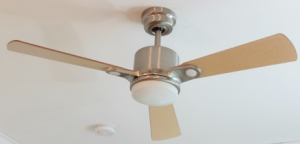Ceiling Fans
If you have tall rooms a ceiling fan can make a real difference to your comfort without large bills.

Summer
While a ceiling fan does not lower the temperature it will make the room feel cooler by:
- The breeze improving the ability of your body to lose heat by perspiration.
- It mixes the cooler air near the floor with the warmer air near your face.
The combined effect is that you feel several degrees cooler.
So you may not have to run the air conditioning as much.
Most ceiling fans use less than 100 watts, which equates to less than 3 cent per hour to run.
Winter
Ceiling Fans can also help lower heating costs in winter.
You can run the ceiling fan in the reverse mode.
This stops hot air staying in the top of the room by pushing warm air up against the ceiling and then down the walls gently re-circulating warm air through the room.
Fan Selection
It’s important to consider the size of the room when selecting a ceiling fan.
The larger the room size the larger the blade diameter and the more powerful the fan motor will need to be to generate enough cooling breeze.
Also a small fan in a large room can make a space look unbalanced whereas a large fan can look overpowering in a small room.
|
Room Area |
Fan Diameter |
|
Up to 7m2 |
92cm (36inches) |
|
7m2 – 13m2 |
92cm – 107cm(36 – 42inches) |
|
13m2 – 20m2 |
122cm – 127cm(42 – 44 inches) |
|
20m2 – 36m2 |
127cm – 132cm(44 – 46inches) |
Installation
Any ceiling fan should be at least 2.1 metres from the floor to the blades of the fan and at least 300mm from the ceiling.
This is a minimum and if you have some basketballers, or ruckmen in the family it may need to be higher.
If you are planning on ceiling fans for a new house it is well worth making the rooms higher.
If you have got cathedral ceilings you can get a ball type fitting to allow them to be fixed to the sloping ceiling.
You can also get extension rods to lower the fan if they are too high to give an effective breeze.
For similar posts see Electrical